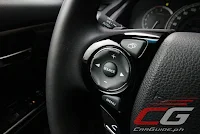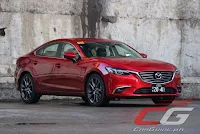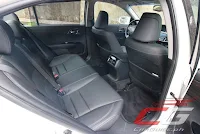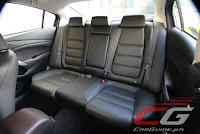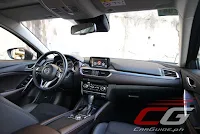Executive sedans were once considered the de facto upgrade for those looking at something more luxurious and sophisticated than a compact car. However, with the proliferation of other choices out there, not to mention the increased specs of the compact cars they’re meant to upgrade from, the executive sedan segment is dying. Today, opting for one of these Japanese mid-sized sedans likely means you’re looking for something chauffeur-driven or something cushy after a long day’s work in the board room.
Be that as it may, there are two executive sedans that don’t fit this norm. Though they’re pretty good sampled as a passenger, they’re best savored from the driver’s seat. These are the 2016 Honda Accord and the Mazda6. The Accord has long been the standard when it comes to sporty mid-sized sedans. Throughout the years, it has always produced a sportier flavor, but still managing to balance fun and comfort. But there’s a new challenger out there, hungry for its throne. Known as the Mazda6, it’s now imbued with style, power, and poise. The question is: can it finally beat the Accord in a head-to-head brawl? Well, it’s time to fire the driver and find out.
Exterior
In their current guise, neither the Honda Accord nor the Mazda6 could be considered as new. Both have been around for a while, with the KODO-fied Mazda being the first to appear in showroom floors in 2013 while the Honda arriving about a year later. Of course, it’s a given that both of these cars have seen substantial tweaks to modernize its styling.
First up is the Mazda6—a car that Mazda designers believe they have struck gold with. Apparently, the design is working (and aging) well that updates were brought in just to unify its look with the rest of the Mazda line-up. Some are arguing though that the designs coming out of Hiroshima are starting to look the same, and rightfully so; but there’s no arguing that it still looks great. It’s especially true with the Mazda6 which happens to look athletic and graceful. In fact, the subtle elements such as the headlights, bumpers, and grille have managed to make it look wider than the Accord—a feat considering it’s actually 10 millimeters narrower than the Honda.
Honda has pretty much done the same thing with the Accord, though this time, it’s not for trying to create a unified look across the product range. Sure, there are elements like the Solid Wing face, but the tweaks have been done to actually clean up the aesthetic mess that the Accord once was. And boy, did Honda get it right this time. The cleaned up look makes the Accord look more regal and believable as an executive sedan than a body racer trying to grow up. That said, there’s still something off with the way it looks. There are lots of needless gashes and lines sprinkled around. It also looks top-heavy, emphasized further by its smallish 17-inch alloy wheels.
Winner: Mazda6
Interior
As captains of industry serving as its primary market, both of these cars have refined interiors that easily justify their price tags. Yet, they’ve also been re-worked, answering to criticisms that they’re offering an experience that too close to that of their small compact sedan siblings.
This year, Honda has swapped certain interior trims to make the Accord look and feel more modern. The faux wood accents have now been minimized; now only found as an insert on the steering wheel and dashboard. Piano black inserts with metallic flakes have taken its place elsewhere from the switch bezels, center console, and even the area surrounding the gear lever. It’s not as scratch-prone as the one found in the Mazda6, and that’s already a plus. The paneling aside, the biggest change here is the new infotainment system. It still uses a dual screen set-up but this new Android-based system is light years better than the old set-up. There’s still some lag to the response, but overall it’s not too bad. And speaking about the dual screen, the larger 8-inch screen is better utilized now and acts as a display for the Lane Watch blind spot, and rear parking camera. Things like navigation are displayed in the slightly smaller 7-inch touchscreen.
Next to the re-worked Accord, the Mazda6’s interior is less fussy and more driver-friendly. It actually feels more upgraded compared to when it first appeared in the market three years ago. Though both of these cars have their share of hard plastics, the Mazda at least has had all its touch points improved. Anything that could be touched or controlled now has soft-touch plastics on them and being matte, they never cause unwanted glare. The new interior palette: black and brown leather with small slithers of aluminum isn’t to everyone’s liking—some found it too muted and dreary—but there’s no doubt it imparts a more Teutonic than Japanese feel. The Mazda Connect with its rotary controller is also far easier to master than the Honda’s system and the response is way snappier. Perhaps the only thing Mazda needs to work on is a new instrument cluster. Though they’re legible, it doesn’t look too differentiated from a more pedestrian Mazda3.
Winner: TIE
Space and Practicality
For potential buyers, this is probably the first and only thing they’ll look at. After all, executive sedans should be as comfortable in the back seat as it is from the driver’s, right?
This is where the Accord makes big gains over the Mazda6. Remember that top-heavy design? Well, the squared-off roofline, upright pillars, and lack of a standard sunroof create better ingress/egress and headroom. Aside from having more room for headwear and funky hairdos, there’s also more available shoulder room—something very evident between the driver and front passenger. However, the high set dashboard and low set seats do compromise the driving position a bit. Despite the wide array of adjustments plus more usable legroom upfront, it rarely feels comfortable next to Mazda’s get in and go set-up. Towards the back, the Accord shines not only because it’s got cushier seats, but because you can actually fit three adults there with enough room to spare for another kid. And for those who find themselves regularly playing golf, the Honda does have a wider, deeper, and longer cargo space. It’s only limited by the single-piece folding rear seat. In this day and age, a 60/40 split-fold mechanism should be standard.
Meanwhile, there’s no question where Mazda put the center of attention in the Mazda6. Compared to the cavernous space offered by the Accord, the Mazda6 feels “just right”—a surprise given it’s dimensionally not far off from the Honda (the Mazda even has a longer wheelbase). It doesn’t feel spectacularly spacious, but it’s not cramped either. The front allows just enough space to stretch legs or spread them apart, but get too comfortable and the padded knee bolsters will get in the way. The other parts of the driving environment from the controls, the seats, the exterior visibility—they’ve been carefully calibrated towards becoming a sharp driving tool. With that, the rear seats are certainly a downer in the Mazda. Not only does the sweeping roofline cause banged heads upon entry or exit, but the seat support isn’t that good and the space isn’t as generous. In addition, the trunk space is limited. Though a split-folding mechanism does supplement it somewhat, the Mazda6 will find it hard to swallow a week’s worth of groceries or luggage for four adults.
Winner: Honda Accord
Performance and Fuel Economy
This is easily the meat of the matter: how does it perform? How does it handle? Which is more fuel efficient? Well, the answer isn’t as straightforward as you think ever since Mazda made the gutsy move to offer the Mazda6 sedan solely with a diesel engine. That’s right, with the 2.5-liter Skyactiv-G moving exclusively to the Sports Wagon variant, this becomes an interesting case of Honda versus Mazda, diesel versus gasoline.
And like any gladiator match, there could only be one winner. In this case, it’s clearly the Mazda6. Some may decry that this match-up is a bit unfair, but consider the numbers: both have four cylinders, both have similar displacements, and both even offer 175 horsepower on tap. The big advantage of the Mazda is that it’s a diesel and as such, it has a Civic’s worth of more torque than the Accord. Lightning quick reactions in stoplight situations, locomotive-like acceleration, and power on demand are a given. But the Mazda6 is more than just a Soul Red-colored Road Runner. It’s also mighty quiet and smooth. It’s mighty efficient too—doing 10.20 km/L in the city (average speed 12 km/h) up to 25.11 km/L on the highway (average speed 86 km/h). Apart from its straight line performance, the Mazda6 also betters the Accord in the way it conducts itself through corners. It eats transition movements for breakfast, only occasionally spitting out hints of understeer. It also feels much more confident under heavy braking. On the flipside, the ride is far less cushy. It’s controlled, but firm. Jolts are largely absorbed, but tire noise is abundant at higher speed. Plus, there’s an obnoxious knocking sound from the front suspension—something that’s become commonplace with the Mazda6.
When not being pushed or carved through traffic, the Accord pretty much matches the Mazda6 in all but perhaps the less than stellar visibility. But roads aren’t made solely of EDSA and as soon as traffic clears up, the Honda begins to show its limits. Though it’s noticeably quieter, smoother, and plusher than the Mazda6, the overall feel is that of isolation. It’s numb all the way from the steering to the chassis; the pedals to the engine; the driver to the car. Don’t get it wrong, it is capable, but the car doesn’t simply communicate well to the driver. Nonetheless, the engine lets out a positive, but muted sound while the accompanying power and acceleration is brisk, especially from mid-throttle onward. The five-speed automatic, though a cog down the Mazda6 is well-suited to the engine. The steering itself is progressive and natural while the brakes still bite well. However, there’s simply no emotion attached to the entire experience. It has, for all intents and purposes, become the appliance of sporty sedans. And once you’re compared to a refrigerator, it’s not exactly a compliment. Further rubbing salt in its wounds, the Earth Dreams engine under the Accord’s hood has really affected fuel mileage which rests at a dismal 5.71 km/L (average speed 11 km/h) going up to 9.48 km/L as the speeds go up (average speed 16 km/h) topping out at 14.37 km/h on the highway (average speed 67 km/h).
Winner: Mazda6
Value for Money
With compact sedans and crossovers now offering increasingly competitive specs, there’s pressure to actually kit-up the executive sedans even more. Both these vehicles offer a substantial upgrade in terms of comfort and convenience technologies, some of which weren’t available in this price range before. That said, around P 200,000 separates the Mazda6 and the Accord with the Honda still coming out as the more affordable of the two. The question is: can Mazda justify its price difference?
When the Accord first came out in 2014, Honda played it conservatively, offering about 90 percent of equipment at 10 percent less cost than the competition. Today though, Honda has rectified this and has begun offering much more equipment at roughly the same price point. Apart from the de rigueur features such as powered leather seats, a fancy infotainment system, GPS navigation, and so forth, the new Accord does add things like cruise control and front proximity sensors to supplement the rear ones. A multi-angle parking camera is also standard on the 4-cylinder variant as well. Even the much vaulted, but equally unnecessary Lane Watch blind spot camera has been added too. It also receives a full complement of LED lighting front and back. What’re missing would be larger alloy wheels and perhaps, rain-sensing wipers. Apart from those, the Accord is looking to be a more complete package.
As good as the Accord is, its biggest problem is the Mazda6. With Mazda opting for a more simplified line-up, the Mazda6 has been kitted to the roof in terms of features; features that easily justifies its higher price tag. Adaptive LED headlights? Check. Gunmetal 19-inch alloy wheels? Check. Sunroof? Check. Powered driver’s seat with memory? Check. An 11-speaker Bose sound system? Check. Heads-up display? Check. Lane Keeping Assist? Check. Lane Departure Warning? Check. Game set and match.
Winner: Mazda6
For the executive who still longs to drive himself, it’s clear that there’s only one real choice. This matchup between the Honda Accord and Mazda6 has produced a new executive sedan king. And in this case, the Mazda6 rules the roost. Although the Accord still manages to strike a good balance between sportiness and comfort, it’s starting to veer too much already to becoming more of a chauffeur-driven car as opposed to an owner-driven one. It’s plush and luxurious, spacious and comfortable, but it’s also largely numb. In the end, it simply cannot match the fun-to-drive qualities of the Mazda6. The Mazda does trade a bit in terms of space and riding comfort for a better driving experience, but in the end, you know which one you’ll be willing drive on a long trip.
Winner: Mazda6
2016 Honda Accord
2.4 S Navi vs. 2016 Mazda6 Skyactiv-D
|
||
| Ownership | 2016 Honda Accord 2.4 S Navi | 2016 Mazda6 Skyactiv-D |
| Year Introduced | 2014 (Refreshed: 2016) | 2013 (Refreshed: 2015) |
| Vehicle Classification | Executive Sedan | Executive Sedan |
| The Basics | ||
| Body Type | 4-door sedan | 4-door sedan |
| Seating | 5 | 5 |
| Engine / Drive | F/F | F/F |
| Under the Hood | ||
| Displacement (liters) | 2.4 | 2.2 |
| Aspiration | Normally Aspirated | Twin Turbo |
| Fuel Delivery | EFI | Direct Injection |
| Layout / # of Cylinders | I4 | I4 |
| BHP @ rpm | 175 @ 6,200 | 175 @ 4,500 |
| Nm @ rpm | 226 @ 4,000 | 420 @ 2,000 |
| Fuel / Min. Octane | Gasoline / 91~ | Diesel |
| Transmission | 5 AT | 6 AT |
| Cruise Control | Yes | Yes |
| Fuel Economy @ Ave. Speed | 5.71 km/L @ 11 km/h 14.37 km/L @ 67 km/h |
10.20 km/L @ 12 km/h 25.11 km/L @ 86 km/h |
| Dimensions and Weights | ||
| Length (mm) | 4,890 | 4,865 |
| Width (mm) | 1,850 | 1,840 |
| Height (mm) | 1,465 | 1,450 |
| Wheelbase (mm) | 2,775 | 2,830 |
| Curb Weight (kg) | 1,542 | 1,537 |
| Suspension and Tires | ||
| Front Suspension | Independent MacPherson Strut | Independent, MacPherson Strut |
| Rear Suspension | Independent, Multi-link | Independent, Multi-link |
| Front Brakes | Vented Disc | Vented Disc |
| Rear Brakes | Disc | Disc |
| Tires | Michelin Primacy 3 ST 225/50 R 17 V (f & r) |
Bridgestone Turanza T001
225/45 R 19 W (f & r) |
| Wheels | Alloy | Alloy |
| Safety Features | ||
| Airbags | 6 | 6 |
| Anti-Lock Brakes (ABS) | Yes | Yes |
| Traction / Stability Control | Yes | Yes |
| Parking Sensors | Front, Rear with Camera | Front, Rear with Camera |
| Other Safety Features | Lane Watch Blind Spot Camera | Lane Departure Warning Lane Keep Assist |
| Exterior Features | ||
| Headlights | LED | LED |
| Fog Lamps | Front | Front |
| Auto Lights | Yes | Yes |
| Rain-sensing Wipers | No | Yes |
| Interior Features | ||
| Steering Wheel Adjust | Tilt/Telescopic | Tilt/Telescopic |
| Steering Wheel Material | Leather | Leather |
| Seating Adjustment | Electric (front) | Electric (front) |
| Seating Surface | Leather | Leather |
| Folding Rear Seat | Yes | Yes, 60/40 |
| On-Board Computer | Yes | Yes |
| Convenience Features | ||
| Power Steering | Yes | Yes |
| Power Door Locks | Yes | Yes |
| Power Windows | Yes | Yes |
| Power Mirrors | Yes, with Fold | Yes, with Fold |
| Climate Control | Dual Zone | Dual Zone |
| Audio System | Stereo CD MP3 USB Bluetooth GPS HDMI |
Stereo CD MP3 USB Bluetooth GPS |
| # of Speakers | 6 | 11, Bose |
| Steering Controls | Yes | Yes |















